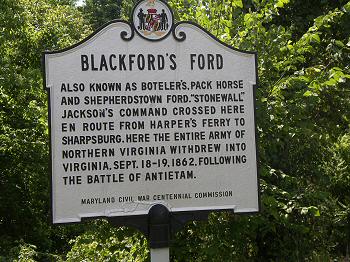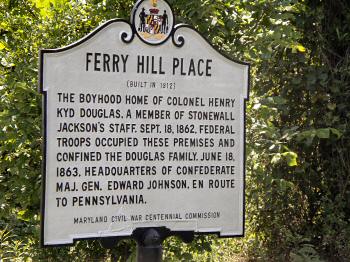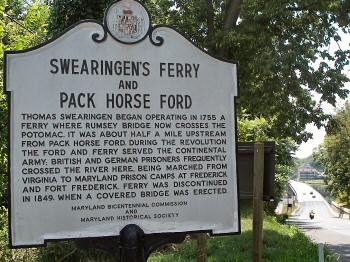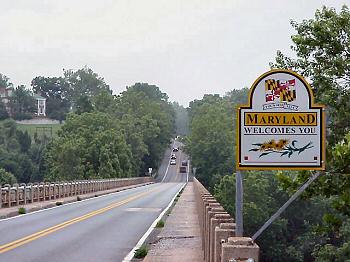|
A day after the tactical draw at
Antietam (September 17, 1862), Robert E. Lee began to pull his Army of
Northern Virginia back across the Potomac at Shepherdstown. General
William Pendleton, Lee's chief of artillery, covered the retreat with 44
guns of the reserve artillery. Pendleton set up his guns atop the high
bluffs overlooking the ford on the Virginia side, above the empty shell of
an old cement mill. The Confederates spent all night wading the river, but
by daybreak nearly the whole of the army was across. Two small brigades of
infantry stayed with the artillery to prevent rapid Union pursuit.
Potomac River Ford
Known as Boteler's Ford, Blackford's Ford, Pack Horse Ford, and other
names, the shallow crossing of the Potomac River less than a mile
downstream from Shepherdstown, West Virginia, was used by travelers since
Native American times. After the highway bridge at Shepherdstown was
destroyed early in the Civil War, the ford was a convenient crossing point
between Confederate Virginia (this area would become West Virginia after
June 20, 1863) and the border state of Maryland. Confederates crossed the
Potomac at Boteler's Ford most notably during the Maryland Campaign of
1862, the Gettysburg Campaign of 1863, and Early's 1864 Raid on
Washington, D.C. The Battle of Shepherdstown occurred when Union forces
attempted to pursue Lee's retreating army after the Battle of Antietam in
September of 1862.
Raid Across the Potomac
Union cavalry arrived on the Maryland side of the river soon after
dawn and began to probe the Confederate position across the Potomac with
artillery and rifle fire. Under orders from McClellan to pursue the enemy,
Fitz John Porter's 5th Corps took over from the cavalry after about two
hours. Porter aggressively put more cannon into position and ordered the
First U.S. Sharpshooters and one company of the 5th New York Infantry
forward. They used the dry trench of the C & O Canal as cover and began to
pick off Confederate gunners on the far side of the river. Some Union
artillery shells crashed into Shepherdstown itself, causing confusion and
chaos among the townspeople and wounded rebels left there.
As the day wore on, the Union fire steadily increased, the Confederate
cannons began to run low on ammunition, and Pendleton spread his infantry
out to cover the guns. The Southern commander gave orders for the cannon
to stay in position until they could withdraw under cover of darkness,
reporting that "it was, of course, a critical and anxious hour."
Pendleton's anxiety increased as Union infantry actually crossed the
river. Just before dark, an attacking party of about 500 men waded across
under the cover of a barrage of fire, and forced the Confederate infantry
back. The Southerners managed to pull most of their cannon out, but the
raiding party was able to capture five pieces. The Yankees pulled back to
the east side of the river for the night, taking their captured guns with
them. In the confusion and darkness, however, Pendleton reported to Lee
that Union forces were in Virginia and had captured the entire reserve
artillery. Lee and Jackson reacted by ordering A. P. Hill's and Jubal
Early's Divisions to stop their withdrawal, turn, and drive the pursuers
back into Maryland.
Battle of Shepherdstown
September 19-20, 1862
As the Confederates reacted to the assumed crisis, Union commanders were
planning a follow-up to their raid. Three brigades from the 5th Corps
crossed the Potomac at 7:00 a.m. and proceeded toward Shepherdstown and
down the Charlestown Road. Advanced skirmishers soon met A. P. Hill's
Division closing in on the ford from the west. With the Confederates
advancing in force, and only a small number of Federals on the Virginia
side, Porter gave orders for all Union troops to return back across the
river into Maryland.
Under the cover of artillery fire from the east bank, the Yankees began to
wade back across. But Colonel Charles M. Prevost, commanding the newly
formed 118th Pennsylvania Infantry (known as the Corn Exchange Regiment),
refused to withdraw until he received orders from his direct superior.
Hill's Confederates smashed into the Pennsylvanians just as they began to
deploy atop the bluffs overlooking the ford.
This was the Northerners' first battle, the first opportunity many of them
had to discover their issued Enfield rifles were defective and would not
fire. Colonel Prevost was wounded trying to steady his men, other officers
led a bayonet charge which was smashed, and the regiment broke apart. Some
tried to escape by climbing down the bluffs under Confederate fire, and
many died as they fell to the rocks below. Others picked their way past
the old cement mill, ran across the slippery dam, or waded across at the
ford. Of the 700 men in the 118th who crossed the river that morning, only
431 came back across.
When the Confederates smashed this attempt by the Union army to pursue
Lee, McClellan was convinced that the Southern army still had plenty of
fight left in it. He decided to delay any further effort to pursue until
reinforced. The Battle of Shepherdstown ended the Maryland Campaign, Lee's
first invasion of the North. |





